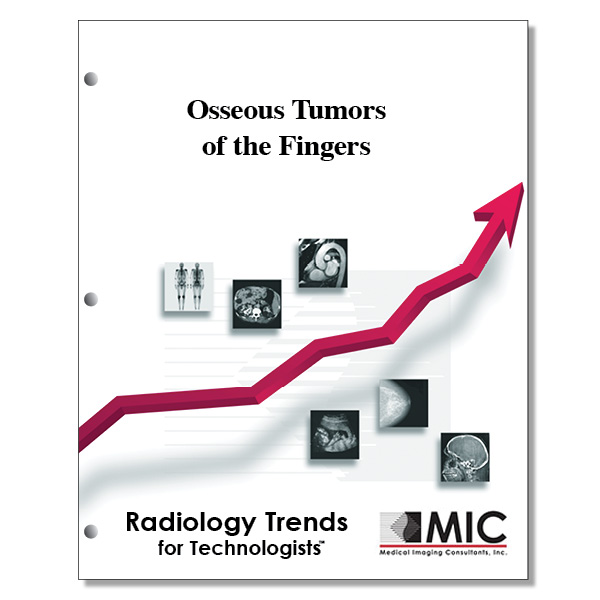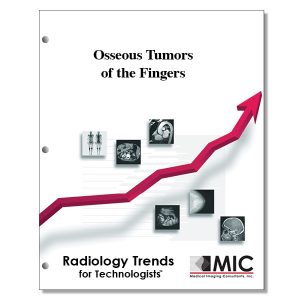

Osseous Tumors of the Fingers
The imaging features of the most common benign and malignant lesions of the fingers are presented.
Course ID: Q00434 Category: Radiology Trends for Technologists Modality: Radiography2.75 |
Satisfaction Guarantee |
$29.00
- Targeted CE
- Outline
- Objectives
Targeted CE per ARRT’s Discipline, Category, and Subcategory classification for enrollments starting after May 25, 2023:
[Note: Discipline-specific Targeted CE credits may be less than the total Category A credits approved for this course.]
Computed Tomography: 2.75
Procedures: 2.75
Head, Spine, and Musculoskeletal: 2.75
Magnetic Resonance Imaging: 1.50
Procedures: 1.50
Musculoskeletal: 1.50
Radiography: 1.50
Procedures: 1.50
Extremity Procedures: 1.50
Registered Radiologist Assistant: 2.75
Procedures: 2.75
Musculoskeletal and Endocrine Sections: 2.75
Sonography: 0.50
Procedures: 0.50
Superficial Structures and Other Sonographic Procedures: 0.50
Radiation Therapy: 2.75
Procedures: 2.75
Treatment Sites and Tumors: 2.75
Outline
- Introduction
- Imaging Modalities and Techniques
- Radiography
- Computed Tomography
- Ultrasonography
- MR Imaging
- Approach to Osseous Tumors of the Fingers
- Benign Lesions of the Fingers
- Enchondromas
- Multiple Enchondromatosis
- Periosteal Chondromas
- Osteochondromas
- Hereditary Multiple Exostoses
- Subungual Exostosis
- Florid Reactive Periostitis
- Bizarre Parosteal Osteochondromatous Proliferation
- Osteoid Osteomas
- Aneurysmal Bone Cysts
- Giant Cell Tumors
- Mimics of Primary Osseous Lesions
- Glomus Tumors
- Intraosseous Epidermal Inclusion Cysts
- Trauma, Infection, and Systemic Diseases
- Malignant Tumors
- Conclusion
Objectives
Upon completion of this course, students will:
- know the prevalence of primary tumors of the hand and fingers
- be able to name the most common benign lesions of the fingers
- know which medical imaging modalities play a role in the diagnosis of lesions in the fingers and hands
- know what information radiography can provide when evaluating a finger lesion
- be able to describe which radiographic views are used to determine finger pathology
- know the proper positioning and exposure techniques for radiography of the fingers
- describe the role of CT in the evaluation of finger lesions
- be familiar with patient positioning for CT of the fingers and hand
- know the benefits of using contrast when performing a CT study of the fingers to determine whether a mass is cystic or solid
- describe what factors determine the appropriate choice of an ultrasound transducer to evaluate finger lesions
- understand the pitfalls of using MR imaging to evaluate finger lesions
- understand proper coil selection for MR imaging of the fingers
- understand patient positioning for MR imaging of the fingers
- be familiar with the typical MR scan protocols for imaging of the fingers
- know what other name multiple enchondromatosis goes by
- understand the complications that can arise with multiple enchondromas
- describe a periosteal chondroma of the finger
- know the radiographic and CT appearance of a periosteal chondroma
- describe an ostechondorama of the finger and its potential complications
- know the two distinctive radiographic appearances of an osteochondroma
- know which medical imaging modality is superior for the evaluation of an osteochondroma
- explain what factors are indicative of a finger exotosis that may be suggestive of malignant transformation
- know what other name hereditary multiple exostoses go by
- describe subungual exostoses and its alternative name
- know the radiographic appearance of subungual exostoses
- know the typical age group affected by florid reactive periostitis
- describe parosteal osteochondromatous proliferation
- describe the radiographic and MR appearance of parosteal osteochondromatous proliferation
- describe osteoid osteomas and what percentage of bone tumors they make up
- understand the nidus component of an osteoid stoma and how it appears on MR imaging
- describe giant cell tumors of the fingers and what percentage of them are malignant
- understand the appearance of giant cell tumors of the fingers on CT and MR
- know what a glomus tumor of the hands is and what percentage of hand tumors they make up
- be familiar with the radiographic and MR appearance of epidermal inclusion cysts
- describe the radiographic and CT appearance of phalangeal chondrosarcomas
